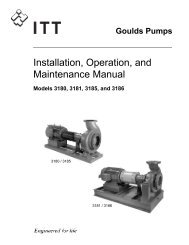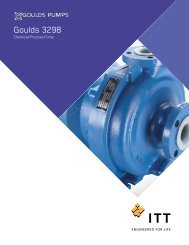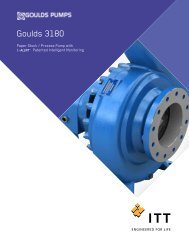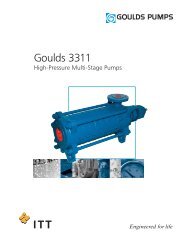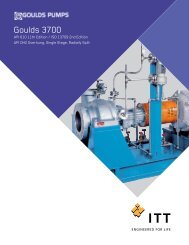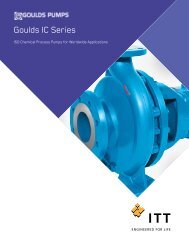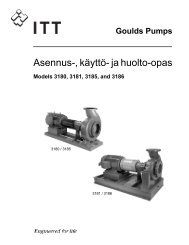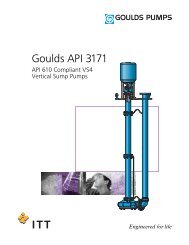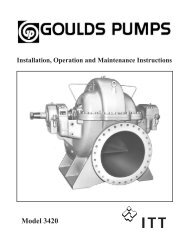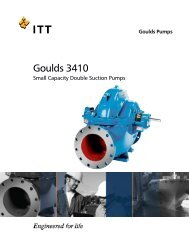Installation Operation and Maintenance Manual
Installation Operation and Maintenance Manual (IOM) - Goulds Pumps
Installation Operation and Maintenance Manual (IOM) - Goulds Pumps
Create successful ePaper yourself
Turn your PDF publications into a flip-book with our unique Google optimized e-Paper software.
Introduction <strong>and</strong> Safety (Continued)Precautions during work• Make sure that you have a clear path of retreat.• Make sure that the product cannot roll or fall over <strong>and</strong> injure people or damage property.• Make sure that the lifting equipment is in good condition.• Use a lifting harness, a safety line, <strong>and</strong> a breathing device as required.• Make sure that the product is thoroughly clean.• Make sure that there are no poisonous gases within the work area.• Make sure that you have quick access to a first-aid kit.• Disconnect <strong>and</strong> lock out power before servicing.• Check the explosion risk before you weld or use electric h<strong>and</strong> tools.Observe these safety precautions when you work with the product or are in connection with the product:• Never work alone.• Always wear protective clothing <strong>and</strong> h<strong>and</strong> protection.• Stay clear of suspended loads.• Always lift the product by its lifting device.• Beware of the risk of a sudden start if the product is used with an automatic level control.• Beware of the starting jerk, which can be powerful.• Rinse the components in water after you disassemble the pump.• Do not exceed the maximum working pressure of the pump.• Do not open any vent or drain valve or remove any plugs while the system is pressurized. Make surethat the pump is isolated from the system <strong>and</strong> that pressure is relieved before you disassemble thepump, remove plugs, or disconnect piping.• Never operate a pump without a properly installed coupling guard.• Always bear in mind the risk of drowning, electrical accidents, <strong>and</strong> burn injuries.• Never heat the condition monitor to temperatures in excess of 300°F (149°C).• Never expose the condition monitor to open flames.• Do not use the condition monitor in atmospheres containing acetic acid.• Always wear protective gloves. The pump <strong>and</strong> condition monitor can be hot.Clean chemicals from the eyes1. Hold your eyelids apart forcibly with your fingers.2. Rinse the eyes for at least 15 minutes.Use an eyewash or running water.3. Seek medical attention.Clean chemicals from the body1. Remove contaminated clothing.2. Wash the skin with soap <strong>and</strong> water for at least one minute.3. Seek medical attention, if required.Safety regulations for Ex-approved products in potentially explosiveatmospheresDescription of ATEXThe ATEX directives are a specification enforced in Europe for electrical <strong>and</strong> non-electrical equipment.ATEX deals with the control of potentially explosive atmospheres <strong>and</strong> the st<strong>and</strong>ards of equipment <strong>and</strong>protective systems used within these atmospheres. The relevance of the ATEX requirements is not limitedto Europe. You can apply these guidelines to equipment installed in any potentially explosive atmosphere.8 Model 3796 i-FRAME <strong>Installation</strong>, <strong>Operation</strong>, <strong>and</strong> <strong>Maintenance</strong> <strong>Manual</strong>




